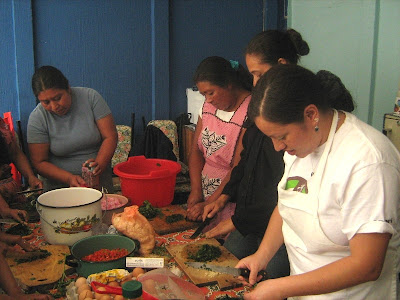Posted on behalf of Scott CotterEvery trip to the field is a whirlwind of motion. We spend our days meeting sponsored children, talking to concerned parents, jostling down rutted dirt roads in underpowered vans and having lengthy discussions about the sometimes overwhelming sights and sounds we’ve encountered.
The days are long and often emotionally draining, yet I think to a person we’d say it’s well worth it. And two days in Guayaquil have reaffirmed a universal truth – that even though poverty is a big problem, it’s the little things that make a big difference. And I hope a few examples from Monday and Tuesday help convey in some small way how true that really is.
The Old Man and the River
Pedro stood barefoot in the rank, trash-filled mud on the banks of the Guayas river, slowly and meticulously smoothing the edge of a battered fishing boat. He didn’t even take notice as our noisy group picked its way down the suspended walkways that strung the homes together above the dirty brown muck.
Jumping down to watch his work, it wasn’t long before we were captivated by the story of his life. He’d been fishing the Guayas since he was 10, which means he has been on that river for about 60 years. With fish populations dwindling, he said it was harder than ever to find food to eat and have enough left over to sell at the market, which was his sole means of contributing to his extended family’s well being.
When his sponsored grandchildren receive school supplies, he said, it means their parents don’t have to spend what little income they earn on tuition, uniforms or other supplies, helping the family save money for other necessities.
A Birthday SurpriseShortly after meeting Pedro, we stopped by the community center in Durán, a community on the edge of Guayaquil. Those of you who’ve been to one of our community centers understand when I say this is where the rubber really meets the road. It was absolute chaos…in a good way.
Children were lining up to receive new shoes and we saw many of them bolting from the fitting room with a grin from ear to ear. There was also a birthday celebration at the center, complete with balloons, streamers and singing. Again, it’s a small thing, but I believe the children really appreciate being made to feel special.
One mother remarked that if not for the gifts her children received from Children International, they’d receive nothing at all.
Gang SignsOf course, a big concern many of the children in Durán and elsewhere face in urban Ecuador is gangs. That’s why we weren’t surprised to find someone at one of our community centers with some inside knowledge.
Luis, 20, was once a sponsored child but left the program when he got involved in a gang. His tattoos tell a story that contradicts the cheerful young man who now volunteers at the community center, teaching others about doing something positive with their lives.
In hushed tones, Luis talks about the things he saw on the street, most of it far too awful to discuss in detail. It was, he said, a sponsored youth’s words that changed the direction of his life. And a youth group activity that helped him finally leave the gang life behind.
A little thing, sure, but it had a lasting impact on Luis. And that’s something he’s passing along to as many others as he can.
A Sponsor’s Gift
One of our last visits in Guayaquil was to Carolina’s house. The 11-year-old is at first quiet and polite, but get her talking about her sponsor and her eyes light up and the shyness dissolves.
Carolina’s sponsor has been to visit her twice and he has always been very generous, helping to improve her home, providing her with furniture and taking her shopping. But it’s not what he can buy for her or the family that Carolina is most interested in. No, when discussing his next visit, which is planned for April 2008, she is most excited about the opportunity to tell him and his family what she has been doing in school.
The other sponsored children living nearby tell her she’s lucky to have a sponsor who comes to visit. And she agrees with a smile.
If you haven’t visited your sponsored child, we urge you to give it some thought. It was clear when we met Carolina that it holds a special place in her heart…as it does for every sponsored child we meet. If you have visited your sponsored child, please think about leaving us a brief comment here about what that meeting was like.
We’re off to Quito now, and tomorrow we hope to bring you more glimpses into the lives of the children and their families that sponsorship helps. And we'll do our best to show you some photos too! Needless to say, we experienced some technological difficulties as we tried to post photos this morning.
 Posted on behalf of Jim Cook, President of Children International.
Posted on behalf of Jim Cook, President of Children International.












.JPG)
.JPG)

.JPG)
.JPG)







